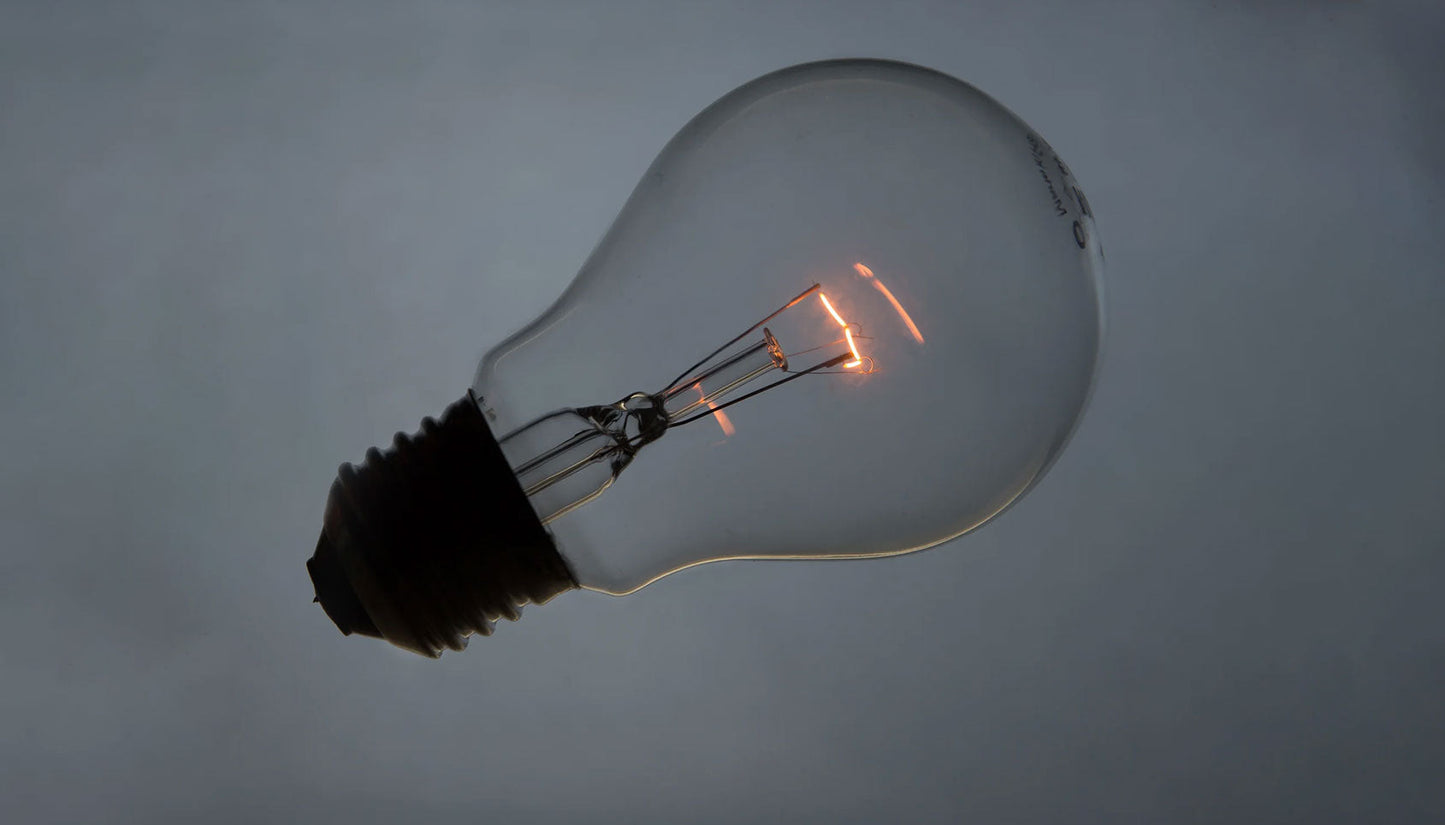We source our chicken from one farm in Leicestershire. The farm is Pasture for Life certified and rears truly free range, outdoor birds.

In Northern Europe suddenly it feels like it's getting dark really early in the day. It's that time of year, the clock has gone back, the skies are often grey and we are subjected to much less natural light than a few months ago.
However, we spend most of our time in the building, sealed off from nature, abstracted from the rhythms of light and the changing seasons, we have artificial light and heat to keep us comfortable, in short, we create for ourselves an artificial summer so we're effectively living in a permanent year-round summer.
You might be thinking, so what? That's great, we're warm, comfortable and productive due to our wonderful technology, but what if this year-round summer is confusing our hormonal balance and making us sick, fat and stressed? To consider this question let’s think about the history of this technology that seems so basic.
Let's go back in time.....
From about 125,000 BC humans gained widespread control of fire and in about 17,500 BC the first oil lamps were created using animal fats as fuel. In about 3000 BC candles were invented.
Fast forward a bit, 1792 William Murdoch began experimenting with gas lighting and probably produced the first gas light. Over 100 years later in 1880 Edison produced a 16-watt light bulb that lasted 1500 hours, this is arguably where things started to change.
Before the advent of reliable controllable lighting humans in high latitudes would have used a bi-phasic sleep pattern. In London UK at 51.5 degrees north, the shortest day of the year on 21st December only offers us 9 hours and 10 minutes of daylight, which leaves a whole lot of darkness in the 24 hours which of course only increases as you move further north (or south on the bottom half of the globe)
Without a Netflix account and recessed down-lighters, our mediaeval predecessors would have had little to do other than sleep, however, even for the most slothful members of society 14 hours until daybreak is a bit too long to sleep.
Research suggests that a bi-phasic or a two-sleep pattern was widely adopted. As the night draws in and it gets dark early our ancestors would have eaten an evening meal and then settled down for the first sleep of a few hours before waking anytime from 23:00 to 2 am, this period of wakefulness that followed was known as "the watch".
Those of a philosophical disposition might use the watch as a peaceful moment to ruminate on life and ponder new ideas but most of all, the watch was useful for socialising and having sex before settling down for the second sleep of the day before awakening at the first light of dawn which in the dead of winter is as late as 8 am even at London’s latitude.
Our pre-industrial ancestors would have only had sources of light that were very 'warm' or low in the Kelvin range as these are generally open flames, they also would have been very dim compared to our modern sources, which would have had a very minimal disruptive influence on our bodies natural diurnal hormone balance. When waking for ‘the watch’ their eyes would not have been subjected to hormone-disrupting colours or intensities of light making it easy to fall back to sleep, there were no I-pads to binge an episode on because you’ve woken up at 1 am.
So what is different between the light used hundreds of years ago and now, we need to look a little into the science of light.
Science time
Light can best be described in two main ways, intensity or brightness and colour temperature. Colour temperature is measured on the Kelvin scale which is a measurement of 'true temperature' starting at absolute zero or -273.15 celsius, this is the temperature at which molecular motion within matter ceases, it's the coldest there is so is given 0 degrees Kelvin, deep space is just about 0 Kelvin.
How this relates to the colour of light is because the temperature of a body or matter determines the colour of light that is emitted heat any matter up and it will eventually start to emit light, think of glowing embers being red and orange and as things get hotter the light they emit gets bluer.
As colour temperature is measured in Kelvin a lower colour temperature relates to a more red/orange light and a higher colour temperature relates to a bluer or whiter light. Examples of this are a candle flame and sunrise or sunset are about 1000k as this light is very ‘warm’, an LCD or CRT screen is about 7000 to 9000 k so very blue-white with traditional light bulbs coming in at 2400 K. Natural full sun daylight is considered to be around the 5600 K mark and a lot of the new LED lighting in our homes is closely matched to mid day sunlight at 5000k. So what? Well, our bodies respond very differently to these different wavelengths of light.
When the sun goes down the pineal is switched on and begins to actively produce melatonin which is released into the blood. Usually, this occurs around 9 pm, just about the time of our ancestor’s first sleep. As a result, melatonin levels in the blood rise sharply and you begin to feel less alert. Sleep becomes more inviting. Melatonin levels in the blood stay elevated for about 12 hours - all through the night - before the light of a new day when they fall back to low daytime levels by about 9 am.
Daytime levels of melatonin are barely detectable. Melatonin is also a powerful antioxidant and has several anti-cancer properties, it also potentially stops your body from gaining more fat.
The production of this crucial hormone is disrupted by the wrong kind of lighting. As we become obsessed with our devices TVs, tablets and smartphones are all putting out daylight-balanced ‘blue’ light which prevents our bodies from converting serotonin to Melatonin and messing without sleep, as are the new LED and energy-efficient light bulbs, it’s crucial to either avoid screens within an hour or 2 of your intended bedtime or use colour changing options to warm the light to help prevent the reduced production.
So how do we get around this?
After all, we need light in our homes to be able to function in the winter and not go to bed at 5 pm in the darkest parts of the year. Whilst we need to be aware of the kelvin colour temperature of light sources around us, this is not the whole answer and is where things get complicated. The Kelvin value alone isn't what determines the effect on melatonin. It depends entirely on the absolute brightness of the blue-green component of the light hitting your eyes. Colour temperature in Kelvin is basically a measure of the relative mixture of red, green, and blue components, but your body only pays attention to the blue-green. A 25-watt 2700K bulb might have less effect on melatonin than a 60-watt 2000K bulb, so the best thing to do is reduce the total amount of light, be brighter, and use a dimmer!
So, how can we be sure that the light bulbs we’re using are not sending the wrong signals to our brains? Simply use old-fashioned tungsten filament or halogen light bulbs, use as low wattage as seems practical and always have them on a dimmer switch, as night draws in start to dim your lights to a deep orange glow. If you like to read in bed to wind down, try reading by candlelight and see how quickly you fall into a deep sleep, after blowing out your candle of course.
So what to do if you find yourself in a hotel room with only white LED lighting and no candles or dimmer switches? The only option here is amber-tinted glasses often called ‘blue blocker’ glasses and easily found online as they can really make a huge difference in those crucial few hours before bedtime, and it goes without saying to stay well clear of TV/computer screens/tablets and other devices that do not have a night shift mode before bedtime.
OK, so let’s assume that you’re at home, all of this makes sense but if you’ve installed white light LEDs in your house at great expense and don’t fancy wearing nerdy wrap-around orange sunglasses after dinner or changing every light bulb in your house, then what? Well, there is another solution, use coloured gels on your existing lights. Coloured lighting gels as used in film and photography can effectively block out the harmful blue of the offending light bulbs and only let pass the right colour, look for something like a Rosco #23 Orange from a pro photography shop and cut to fit around the offending bulbs, this might seem very orange but as you get used to the soothing glow and start to sleep better the health benefits will start.
However, even if your light is the right colour when you’re sleeping you need it to be dark, really dark, can’t see your hand in front of your face dark. Studies have shown that light levels of even 0.2 Lux, which is less than a small candle can adversely affect melatonin production, the only way to deal with this is full black-out blinds, eye masks are a second best option as any other exposed skin can react to less than perfect darkness. This is especially important for those in urban areas where light pollution comes in through the window,
You might have noticed that the once familiar orange glow of our cities is changing to white light. This is because the high-pressure sodium lamps that emit the classic orange glow, which is less damaging to our hormonal health, are being replaced by modern LED equivalents giving out a daylight-balanced white light. The reason orange lights were used initially was simply economic, before LED technology came of age the sodium lamps simply produced the most output for electricity usage, the new white light street lamps are destroying people’s circadian rhythms, if you’re unlucky enough to have this type of light pollution streaming in through your windows then blackout blinds are essential.
Unfortunately light isn’t the only part of the electromagnetic spectrum we need to consider in order to sleep better and improve our health, we are bombarded by a vast range of this type of radiation from cell phones, tablets, computers, wifi routers, cell towers, televisions and the general electrical hum from the wires in our homes.
Researchers have found that EMFs hinder the production of melatonin and also impact our cells so that they can’t take in the melatonin that is produced. This allows cell proliferation of malignant cells and disrupts cell-signalling systems, which determines how a cell responds to its environment.
So what can you do to minimise these effects?
The best way to start is by taking some simple measures, never sleep with your mobile phone close to your head, ideally, have it in aeroplane mode if you need to use it as an alarm or simply switch it off if not. If you have a wifi router in your house a really simple hack is to install a cheap timer plug to the power supply so that at a specified time, say 10 pm, your wifi power switches off, this will also stop you from binge-watching on a tablet in bed, that ‘just one more episode’ decision can’t be made.
Apart from that, consider the electrical hum from your household electronics, a study published by the World Health Organisation in 2016 cited a 50-60Hz frequency to be particularly disturbing to our bodies with children suffering more than adults, this is the frequency of the alternating current in our homes. Simply turning off our devices with the power button on the front isn’t good enough, if you can see an LED light showing that the appliance is in standby mode or ‘off’ then there is still an electrical supply to the transformer within the appliance, you need to turn the device off at the plug or unplug it completely to create your sleeping cave, again if you need to use an alarm clock chose a battery operated or a mechanical one.
Essentially the closer you get to making your bedroom into a prehistoric cave, the better, deeper and longer you will sleep, the better your hormones will be balanced, and you’ll be less physiologically stressed, happier, healthier and probably slimmer.
New LED lighting seems amazing, we get more light for less energy usage and bulb life is measured in decades rather than hours but there’s a big price to pay and it’s hitting our waistlines.
About now, or even a while ago you might be thinking....'that's great and all but why is an online butcher writing about light bulbs?'
Read part two to find out how our 'eternal summer of light' is at odds with seasonal patterns of food availability in the north and how we can negate these effects through changing our macro-nutrient ratios.



